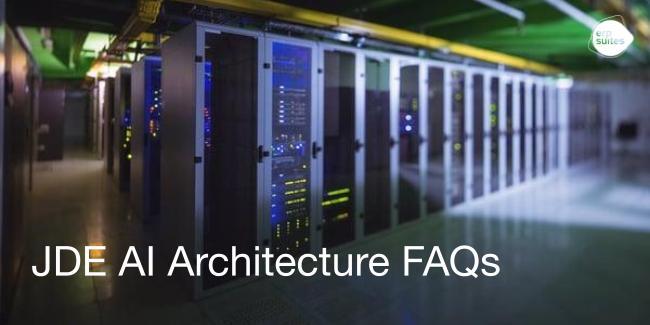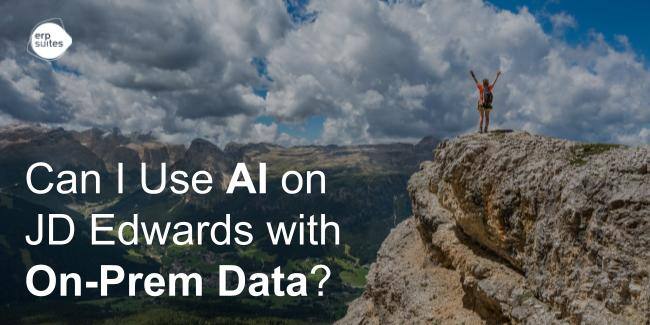How Much Does JD Edwards Cloud Hosting Cost?
January 31st, 2025
6 min read
.png?width=650&height=325&name=Blog%20Images%202_1%20(5).png)
If you’ve landed on this blog, you’re thinking about JD Edwards (JDE) hosting. Which means you’re probably also thinking: How much does it cost? It's an essential question, but there are some variables. That’s because JDE hosting costs vary depending on your business’s size and requirements.
You want to balance your budget and your business’s best interests. You need a secure choice for hosting your JDE, but you need to be cost effective, too. Depending on the platform you use for your JD Edwards environment - SQL, IBMi, or Oracle DB - your hosting costs will range anywhere from $6,000 per month to $11,300 per month.
As ERP Suites, we’ve taken many of our clients through this decision-making process. You’re not alone in making cost consideration a top priority. Our team of experts has 500+ years of collective experience with JD Edwards and in this field to help you understand the best option for your business. Even if you don’t choose to host your JDE with us, we want you to understand what hosting entails.
That’s why we’re here – to help you get JDE cloud hosting cost clarity.
In this article, you’ll learn about the average costs, key factors that influence pricing, hidden fees to watch out for, and actionable tips to save money without compromising performance.
How Different JD Edwards Cloud Hosting Environments Impact Cost
The cost for hosting JDE depends on where you run your software: in the cloud, on-premises, or in a private data center managed by a hosting provider.
We’re going to cover outsourced JD Edwards hosting services in this article, though on-premises hosting is possible should you choose to do so. If a user chooses to have infrastructure on site, they typically will end up paying more for that typically. They will also pay for it all up front.
Hosting in the cloud versus on-premises is like owning a house versus renting an apartment. When you own a house, you have made an up-front purchase that you then pay off in monthly installments via your mortgage. All repair, maintenance and additional and unexpected fees are your responsibility. Same principle goes for being hosting on-premises. Companies that choose an on-premises hosting solution are often in a highly regulated industry that requires total control over their data.
Whereas if you rent an apartment, you’re usually in a multitenant apartment. Costs are split out depending on your particular apartment and lease arrangement. You don’t pay for repairs, however, or general maintenance and upkeep. The landlord or leasing company takes care of all that. Same goes for public cloud providers. Oracle Cloud Infrastructure (OCI), for example, operates on a multitenancy model, meaning many people use its services at one time. All of OCI’s maintenance requirements and associated costs are their responsibility, not the user’s.
Some businesses opt for managed services from third-party providers. These providers (like ERP Suites) host, monitor and maintain their JDE systems. Managed services typically include managing the infrastructure, monitoring systems, and ensuring updates and compliance.
Public Cloud
Hosting JDE on platforms like Oracle Cloud Infrastructure (OCI), Amazon Web Services (AWS), or Microsoft Azure. These public platforms provide scalable and flexible infrastructure where businesses pay for what they use.
Private Cloud
Hosting JDE in a dedicated environment managed by a hosting provider, offering greater control, security, and customization. Companies (like ERP Suites) offer private cloud options within their purview.
Hybrid Cloud
Combining public and private cloud environments to meet specific business needs. This could mean using the public cloud for non-critical tasks but keeping super sensitive data in a private cloud.
Businesses choose to outsource host for a variety of reasons. It’s a more cost-efficient option that gives businesses a lot of flexibility. They can scale their resources on a usage basis. Hosting means access to expertise you might not necessarily have in-house. It can also be a more secure option; hosting providers often have advanced security measures to protect your data.
What Factors Influence JD Edwards Hosting Costs?
Hosting costs can vary greatly depending on your business’s size and needs. The factors that influence hosting costs the most include:
- Business size and user count
- Storage and database size
- Infrastructure type: Public vs. Private cloud
- Performance requirements
- Disaster recovery and backup needs
Business Size and User Count
The number of concurrent users directly impacts hosting costs. Think of it like a restaurant kitchen: the more orders (or user requests) you’re processing simultaneously, the more resources you need to ensure performance doesn’t suffer.
For small businesses with fewer than 100 users, costs are on the lower end. Larger enterprises with 750+ concurrent users will require significantly more infrastructure, driving up costs.
In the private cloud, pricing is not done by users. In the public cloud, concurrent users put a certain load on the platform, and is a primary cost concern.
Storage and Database Size
Storage needs to grow with your data. A larger database means more disk space, backups, and disaster recovery (DR) capacity. Think of this like moving into a bigger house — not only do you pay for the extra square footage, but also for the upkeep, such as heating and cleaning.
Small databases may incur minimal costs. Large, complex databases can result in significant storage and DR expenses.
Infrastructure Type: Public vs. Private Cloud
Some of the most popular public cloud providers on the market these days are huge corporations. Providers like OCI or AWS offer flexibility, scalability, and global infrastructure. However, these benefits come with added costs for premium services like high-performance storage.
On the private cloud front, you have any number of businesses that utilize their own cloud. While offering more control and security, private cloud solutions might require higher upfront investments but can be cost-effective in the long term.
Performance Requirements
Certain workloads, like running real-time analytics or handling large transaction volumes, demand high Input/Output Operations Per Second (IOPS) from storage. Faster, high-performance storage solutions cost more, but they’re crucial for businesses with heavy processing needs.
Disaster Recovery (DR) and Backup Needs
The cost of Disaster Recovery depends on how quickly you need to recover in the event of an outage (Recovery Time Objective or RTO) and how much data loss you can tolerate (Recovery Point Objective or RPO).
- Hot DR: Immediate recovery with minimal data loss; highest cost.
- Cold DR: Slower recovery times and some data loss; lower cost.
For example, a business that needs systems operational within two hours will pay significantly more than one that can wait 48 hours.
What is the Average Cost of Hosting JD Edwards?
Remember, the average cost is dependent on all the factors listed above. Let’s consider the cost of hosting JDE for a midsize business called Business X.
Business X is in the manufacturing sector. They run on the Oracle DB server, and have 11 virtual machines (VMs). They have typical storage needs, and typical business configurations for similar businesses in size and structure.
Given all these details, Business X can expect to pay between $6,000 and $9,000 for hosting JDE in the public or private cloud. Some businesses might have needs and sizes that mean their cost ranges anywhere from $10,000 per month to $70,000 per month.
However, these numbers can fluctuate depending on your provider. In the public cloud, generally speaking, OCI is 15% less expensive than AWS. Private cloud hosting falls somewhere in between OCI and AWS in terms of cost.
For example, if your baseline cost is $10,000/month, hosting on OCI might cost $8,500, while AWS could cost $11,500. These differences reflect Oracle’s competitive pricing to attract JDE users and AWS’s robust infrastructure advantages.
What Are Some Hidden and Variable Costs of Hosting JD Edwards?
While many costs are predictable, others might catch you off guard. Here are the most common hidden or variable costs. Some are one-time, but most are ongoing.
Ingress/Egress Data Fees
Public cloud providers often charge fees for data moving into (ingress) and out of (egress) their environments. If you frequently transfer large amounts of data between clouds or back to on-premise systems, these costs can add up quickly. OCI, for instance, includes 10 TB of free egress data, while AWS charges per GB after a certain threshold.
Your usage depends on your data needs. You pay this cost when the data ingress or egress is actually in process. If your data isn’t in transit, then you’re not paying for either ingress or egress charges.
Third-Party Applications
Many businesses rely on additional applications that integrate with JDE, such as barcode scanning software or tax automation tools. Hosting these alongside JDE can increase server requirements and associated costs.
This cost depends on the third-party application vendors themselves. Typically, they follow a SaaS model, and are charged on a monthly basis. However, some are a one-time purchase. Microsoft licensing, in many cases, you will pay up front for that licensure. JD Edwards itself is purchased at one time, similar to many other older legacy applications.
Licensing Fees
Each cloud provider licenses software differently. For example, running an Oracle database in AWS can cost significantly more than running it in OCI due to licensing rules. Misunderstanding these rules could result in unexpected expenses, sometimes to the tune of hundreds of thousands of dollars.
What Are Some Cost-Saving Tips for Hosting JD Edwards?
There are ways to reduce your hosting expenses without sacrificing performance. Here are some actionable tips:
Right-Size Your Resources
Many businesses overestimate their resource needs. Carefully analyze your usage patterns to scale your infrastructure appropriately. You don’t want to pay for unused capacity. If your business experiences high traffic only during specific months, you can adjust your cloud resources accordingly.
Optimize Disaster Recovery Plans
Do you need instant recovery for all servers? Consider prioritizing critical systems for hot DR while using cold DR for non-essential systems. This balance can significantly lower your DR costs.
Consolidate Third-Party Applications
If possible, minimize the number of third-party applications you integrate with JDE. Alternatively, host them in the same environment as JDE to avoid performance and data transfer issues.
Leverage Discounts and Incentives
Cloud providers often offer discounts for long-term commitments or reserved instances. Additionally, Oracle provides incentives for hosting JDE in OCI, which could result in significant savings compared to AWS or Azure.
Plan for Long-Term Cost Efficiency
Switching to cloud hosting can shift expenses from CapEx (capital expenditures) to OpEx (operational expenditures), spreading costs over time. While upfront savings are appealing, the real benefit is the ability to scale as your business grows.
How Can You Get an Accurate JD Edwards Hosting Cost Estimate?
Now you know that each business that needs JD Edwards hosting services has different moving parts and different requirements.
With all these factors at play, it’s hard to pinpoint an exact cost for your JD Edwards hosting needs in an article alone.
At ERP Suites, we’re here to help you navigate this process, and we can get you the answers you need.
If you’re not in the cloud yet but think it’s right for you and your hosting needs, take this assessment.
If you want to consider ERP Suites Private Cloud, check out our detailed pricing page and schedule a call with a cloud expert.
Leyla Shokoohe is an award-winning journalist with over a decade of experience, specializing in workplace and journalistic storytelling and marketing. As content manager at ERP Suites, she writes articles that help customers understand every step of their individual ERP journey.
Topics:



.png?width=650&height=325&name=Blog%20Images%202_1%20(4).png)
.png?width=650&height=325&name=Blog%20Images%202_1%20(3).png)
.png?width=650&height=325&name=Blog%20Images%202_1%20(2).png)
.png?width=650&height=325&name=Blog%20Images%202_1%20(1).png)
.png?width=960&height=540&name=Blog%20Images%20(96).png)

.png?width=960&height=540&name=Blog%20Images%20(90).png)
.png?width=960&height=540&name=Blog%20Images%20(88).png)
.png?width=960&height=540&name=Blog%20Images%20(87).png)
.png?width=960&height=540&name=Blog%20Images%20(86).png)
.png?width=960&height=540&name=Blog%20Images%20(85).png)
.png?width=960&height=540&name=Blog%20Images%20(83).png)
.png?width=960&height=540&name=Blog%20Images%20(82).png)
.png?width=960&height=540&name=Blog%20Images%20(80).png)
.png?width=960&height=540&name=Blog%20Images%20(79).png)
.png?width=960&height=540&name=Blog%20Images%20(78).png)
.png?width=960&height=540&name=Blog%20Images%20(77).png)